10 Deleted Scenes That Explain Confusing Star Trek Moments
So where did Nero go for 25 years?!

Like all major Hollywood franchises, Star Trek's history is full of what-ifs and alternate versions of episodes and movies we never got to see.
We've been treated to director's cuts of Star Trek: The Motion Picture, The Wrath of Khan, and The Undiscovered Country, as well as extended episodes of Star Trek: The Next Generation released when that series was remastered for blu-ray. Still, there exists numerous other missing scenes or deleted material for extended editions and ultimate cuts that will likely never see the light of day.
Some of these deleted scenes are just fun additions (Kirk skydiving in Star Trek Generations, anyone?) and still others would explain points of confusion and mysteries that have cropped up over the films and episodes . With that in mind, here are 10 mysteries from Star Trek films and television episodes and the deleted scenes that explain them all away.

10. Star Trek Generations - Soran Tortures Geordi
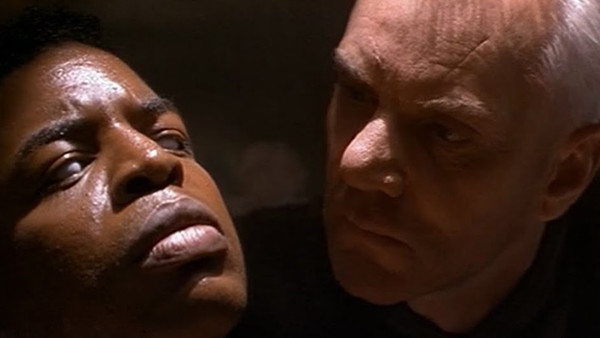
The Mystery:
What did Soran mean when he told the Duras Sisters Geordi's "heart just wasn't in it" after they captured LaForge in Star Trek Generations?
The Deleted Scene:
Likely deleted to retain the family friendly PG rating, a torture scene was filmed but ultimately removed from Star Trek Generations that featured Soran torturing a captured Geordi LaForge.
While the scene in the theatrical cut ends with LaForge strapped to a table and Soran asking him about trilithium, the sequence was meant to continue and show Soran attempting to find out exactly what the crew of the Enterprise-D knows about his plan and what, if anything, Guinan told them about his past. While LaForge keeps his answers technical, Soran isn't satisfied and uses a Borg nanoprobe to stop Geordi's heart to motivate the engineer to talk.
The torture apparently still doesn't work, but Soran has heart jokes. He tells LaForge in the deleted scene he can tell Geordi has "a good heart" and later, in the theatrical cut, there's the whole "his heart just wasn't in it" line. Also in the final cut, Doctor Crusher can later be heard telling Geordi she's removed the nanoprobe and that she thinks he's going to be fine. Tough guy that LaForge.
I played Shipyard Bar Patron (Uncredited) in Star Trek (2009).
- Movies & TV
- Big on the Internet
- About Us & Contact
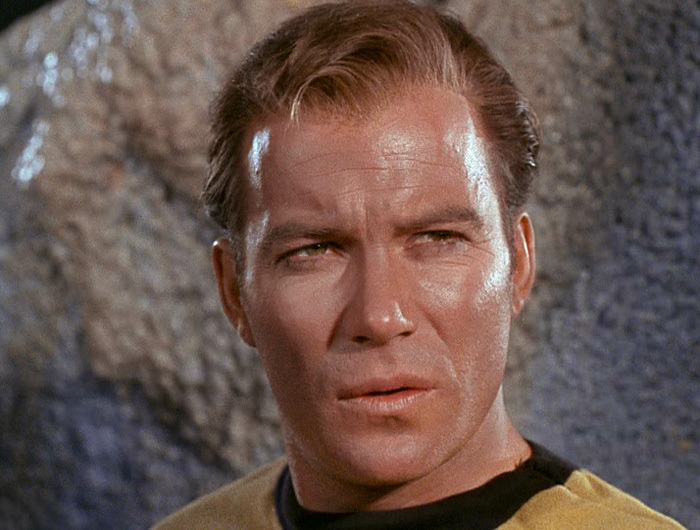
Here’s Why the William Shatner Cameo Didn’t Happen in Star Trek
Back in 2009, a scene that featured a holographic cameo appearance by William Shatner ‘s Captain Kirk in the Star Trek reboot was revealed without an explanation as to why it wasn’t included in the film. But now, co-writer Bob Orci is telling everyone why the cameo was ultimately cut from the final script: it was seen as 1. not powerful enough and 2. “pandering.” Hmmm. We have the scene here so you can judge for yourself.
When asked at a round table discussion with The Hollywood Reporter if there were ever scenes that were written but not used, Orci responded:
We wrote a scene for William Shatner at the end of the movie where Spock, played by Leonard [ Nimoy ], gives his young self, played by Zach Quinto , something he’d kept with him. And it was basically a recording of Kirk singing “Happy Birthday” to him for the last time before he went off to die in Star Trek VI . J.J. [ Abrams ] had determined early on that he felt it might seem like it was, a) too small, and b) pandering to the fans a bit. But we wrote it anyway because as a fan you’re always trying to protect that thing where you want to be able to look fans in the eye and say, “We were ready.”
TrekMovie has actually obtained a copy of the script for this scene, known as “Alternate Scene B,” which was never even seen by Shatner and would have created a completely different version of the scenes involving Spock Prime and Spock. There is also no time stated for Kirk’s recording, but it would have been faithful to the Star Trek canon.
Here is the entire scene:
ALTERNATE SCENE B SPOCK PRIME Then I ask that you do yourself a favor… put away logic, and do what feels right. The world you’ve inherited lives in the shadow of incalculable devastation… but there’s no reason you must face it alone. And from around his neck, he removes the PENDANT that until now, we’ve only caught glimpses of. Places it on the table beside his younger self. The feeling in his eyes is profound… SPOCK PRIME (CONT’D) This was a gift to me. Representing… a dream. One we were unable to fulfill. (softly) The way you can now. And moves to the door. Stops. Offers the VULCAN SALUTE: SPOCK PRIME (CONT’D) As my customary farewell would appear oddly self serving, I will simply say… good luck. Their eyes hold. Spock turns, disappearing into the corridor. Young Spock stares at the empty doorway a beat, his mind a jumble of thoughts. Looks to the pendant… and realizes it’s a HOLO-EMITTER. After considering a beat, he hits an activation button and a MOVING HOLOGRAPHIC MESSAGE materializes before him: CAPTAIN JAMES T. KIRK. WILLIAM SHATNER. As always, brash, wry, confident — and SINGING: KIRK/ SHATNER Happy birthday to you, happy birthday to you… (stops, grins) I know I know, it’s illogical to celebrate something you had nothing to do with, but I haven’t had the chance to congratulate you on your appointment to the ambassadorship so I thought I’d seize the occasion… Bravo, Spock — they tell me your first mission may take you away for awhile, so I’ll be the first to wish you luck… and to say… (beat, emotional) I miss you, old friend. … and we’re PUSHING IN on Young Spock, taking in the image of Kirk’s future self, the message, but above all — the clear, unquestionable friendship these two men had… INT. CORRIDOR – CONTINUOUS As Spock Prime walks off down the corridor, he passes right by a man conferring with a nurse — the man pauses, turns… it’s SAREK. Suddenly overcome by a feeling that the stranger who’s just passed him is… oddly familiar. KIRK/SHATNER (V.O.) I suppose I’d always imagined us… outgrowing Starfleet together. Watching life swing us into our Emeritus years… INT. STARBASE ONE – HANGAR – ETERNAL NIGHT MUSIC BUILDING — glass walls reveal THE ENTERPRISE at dock, UTILITY CRAFTS floating around it, repairing. Standing at attention in rows, THE ENTERPRISE CREW — over four hundred of them wearing DRESS UNIFORMS — TRACK DOWN the faces, all proud: KIRK/SHATNER (V.O.) I look around at the new cadets now and can’t help thinking… has it really been so long? Wasn’t it only yesterday we stepped onto the Enterprise as boys? That I had to prove to the crew I deserved command… and their respect? And we STOP ON YOUNG KIRK. Composed, focused, proud. A man. And to every fan’s delight, finally wearing his YELLOW SHIRT. The FEDERATION COMMANDANT stands at a podium: COMMANDANT This assembly calls Captain James Tiberius Kirk… Kirk breaks from formation, pivots, marches down the hangar — past UHURA… SULU… CHEKOV… SCOTTY. All Beaming. Notably absent, is Spock. Kirk ascends the stairs, snaps to attention: COMMANDANT (CONT’D) Your inspirational valor and supreme dedication to your comrades are in keeping with the highest traditions of service and reflect utmost credit to yourself, your crew, and the Federation. By Starfleet Order 28455, you are hereby directed to report to Commanding Officer, USS Enterprise, for duty as his relief. Kirk turns. Walks to… PIKE. In a wheelchair now, wearing an ADMIRAL’S UNIFORM. Overnight, his hair’s turned totally grey — but despite his trauma, his pride’s overwhelming. They SALUTE each other: KIRK I relieve you, Sir. PIKE … I am relieved. He opens a BOX in his lap — glorious in repose, a MEDAL: PIKE (CONT’D) And as Fleet Admiral, for your… unique solution to the Kobayashi Maru, it’s my honor to award you with a commendation for original thinking. Pike containing a smirk, pins the medal to Kirk’s chest… PIKE (CONT’D) (a touch choked) Congratulations, Captain. KIRK Thank you, Sir. Kirk turns to the crowd. Eyes shining. WILD APPLAUSE. OUR MUSIC SOARS. Bones leans in to Sulu, rolling his eyes: BONES … Same ship, different day. As Kirk rejoins his crew for hugs and congratulations, we go to the BACK of the hangar… SPOCK PRIME. Watching. Moved beyond words. He turns and leaves them to it… as he goes… KIRK/SHATNER (V.O.) I know what you’d say — ‘It’s their turn now, Jim…’ And of course you’re right… but it got me thinking: INT. STARFLEET HOSPITAL – EARTH – DAY Our montage comes full circle as we END on Kirk’s transmission: KIRK/SHATNER Who’s to say we can’t go one more round? By the last tally, only twenty five percent of the galaxy’s been chartered… I’d call that negligent. Criminal even — an invitation. You once said being a starship captain was my first, best destiny… if that’s true, then yours is to be by my side. If there’s any true logic to the universe… we’ll end up on that bridge again someday. Stops, grins. Because this is the part he needs to say most… KIRK/SHATNER Admit it, Spock. For people like us, the journey itself… is home. Young Spock’s face. Lost in feelings that flood through him.
( TrekMovie via Blastr )

Log in or Sign up
You are using an out of date browser. It may not display this or other websites correctly. You should upgrade or use an alternative browser .
Spoilers Deleted Scenes - Season 1
Discussion in ' Star Trek: Discovery ' started by Lord Garth , Dec 29, 2018 .
Lord Garth Admiral Admiral
I bought DSC S1 on Blu-Ray and am about to watch the Deleted Scenes shortly. I don't see a thread on this, so might as well put one up!
Vger23 Vice Admiral Admiral
I thought the deleted scene from "Butchers Knife," showing the conversation on the ship of the dead just prior to Kol's arrival was valuable. I also thought the additional scene of young T'Kuvma in "Battle at the Binary" was pretty good. The extra little scene in M2MTSMGM was pretty much a waste.
I wish they NEVER cut that scene where Georgiou was enlisted into Section 31. They should've kept that in. BUT at the same time, I don't see where it would've fit into "Will You Take My Hand?" I hope they work that scene into the beginning of Georgiou's first episode in S2. "Previously on Discovery ..." and then show the scene. They've kind of done that before with BSG where they'd retroactively add some things into the recap. I'm thinking specifically of "The Captain's Hand" where they add in Adama telling Tigh (?) he's assigning Garner to take command of the Pegasus because he's the best they've got. They also should've kept the scene with Stamets, Tilly, and Saru where Stamets is trying not to think of Culber. In "The Butcher's Knife", at the end of the Deleted Scene, was the TOS-style D7 a stand-in for a DSC-style D7 before they added it in? Either I'm not remembering something correctly... or they purposely didn't want to show their hand with the TOS D7 and cut it. EDIT : I have to re-watch that. I've got something wrong.
Lord Garth said: ↑ I wish they NEVER cut that scene where Georgiou was enlisted into Section 31. They should've kept that in. BUT at the same time, I don't see where it would've fit into "Will You Take My Hand?" I hope they work that scene into the beginning of Georgiou's first episode in S2. "Previously on Discovery ..." and then show the scene. They've kind of done that before with BSG where they'd retroactively add some things into the recap. I'm thinking specifically of "The Captain's Hand" where they add in Adama telling Tigh (?) he's assigning Garner to take command because he's the best they've got. They also should've kept the scene with Stamets, Tilly, and Saru where Stamets is trying not to think of Culber. In "The Butcher's Knife", at the end of the Deleted Scene, was the TOS-style D7 a stand-in for a DSC-style D7 before they added it in? Either I'm not remembering something correctly... or they purposely didn't want to show their hand with the TOS D7 and cut it. Click to expand...
thribs Vice Admiral Admiral
For all we know, that scene where she is enlisted is in season 2.
Warp Core Breach Commodore Commodore
If you compile the deleted scenes to they make for a more interesting and similarly disjointed ride than STD s1?
Warp Core Breach said: ↑ If you compile the deleted scenes to they make for a more interesting and similarly disjointed ride than STD s1? Click to expand...
Noname Given Fleet Admiral Admiral
Lord Garth said: ↑ I wish they NEVER cut that scene where Georgiou was enlisted into Section 31. They should've kept that in. BUT at the same time, I don't see where it would've fit into "Will You Take My Hand?" I hope they work that scene into the beginning of Georgiou's first episode in S2. "Previously on Discovery ..." and then show the scene. They've kind of done that before with BSG where they'd retroactively add some things into the recap. I'm thinking specifically of "The Captain's Hand" where they add in Adama telling Tigh (?) he's assigning Garner to take command of the Pegasus because he's the best they've got. They also should've kept the scene with Stamets, Tilly, and Saru where Stamets is trying not to think of Culber. In "The Butcher's Knife", at the end of the Deleted Scene, was the TOS-style D7 a stand-in for a DSC-style D7 before they added it in? Either I'm not remembering something correctly... or they purposely didn't want to show their hand with the TOS D7 and cut it. EDIT : I have to re-watch that. I've got something wrong. Click to expand...
Noname Given said: ↑ I'm glad they cut it because I'm sure some (who don't follow Star Trek like a religion. ) will ENJOY the surprise of seeing Empress Gergiou pop up surprisingly on the Discovery in Season 2. Not everything needs to be spelled out on screen. Click to expand...
DaveyNY Admiral Admiral
Lord Garth said: ↑ I agree with your point... but that's not why I wish it wasn't cut. The way that scene was shot, looks like it could've been in Blade Runner . Anything that reminds me of Blade Runner is always a plus. Click to expand...
gblews Vice Admiral Admiral
gblews said: ↑ Can you describe the scene? Click to expand...
Lord Garth said: ↑ Mise en scene. I haven't done that since college.* A picture is worth 1,000 words, so stand by. * I had to spend three pages describing a single frame in a film, it's composition, what it symbolized, and on and on. That's college for you. EDIT : Here's the deleted scene from "Will You Take My Hand?" And here's the trailer for Blade Runner ... Blade Runner by the way, is my favorite film of all-time. Runners up are Back to the Future, Bonnie & Clyde, and Rosemary's Baby . And for good measure: Don't Tell Mom the Babysitter's Dead . But Blade Runner ... it's not just "More Human Than Human" but "More Classic Than Classic". The Orion Embassy in "Will You Take My Hand?" also reminds me of downtown in Blade Runner . @gblews Click to expand...
Only seen the theatrical version of Blade Rinner and I didn’t think much of it. Been meaning to watch the Final Cut.
guyute03 Rear Admiral Rear Admiral
Absolutely should have had the Section 31 scene IN the actual season. It is an extremely important plot point going forward and I hate seeing it relegated to a place where many people may not even see it. Hopefully it is revisited in some fashion in season 2.
Lord Garth said: ↑ Mise en scene. I haven't done that since college.* A picture is worth 1,000 words, so stand by. * I had to spend three pages describing a single frame in a film, its composition, what it symbolized, and on and on. That's college for you. EDIT : Here's the deleted scene from "Will You Take My Hand?" And here's the trailer for Blade Runner ... Blade Runner, by the way, is my favorite film of all-time. Runners up are Back to the Future, Bonnie & Clyde, and Rosemary's Baby . And for good measure: Don't Tell Mom the Babysitter's Dead . And I might as well round out my Top Five with Network . But Blade Runner ... it's not just "More Human Than Human" but "More Classic Than Classic". The Orion Embassy in "Will You Take My Hand?" also reminds me of downtown in Blade Runner . @gblews Click to expand...
Vger23 said: ↑ Blade Runner is among my all-time favorites as well. Others are Field of Dreams, The Matrix, 2001: A Space Odyssey, and Raiders of the Lost Ark. I guess I'm a sucker for sci-fi/fantasy. Click to expand...
DaveyNY said: ↑ My best movie theater experience EVER, was seeing Raiders of the Lost Ark. I had gone to the Friday opening-day matinee of "OUTLAND" on Memorial Day weekend. (which was a good movie too) Just as the credits started to scroll, the house lights came on and one of the theater employees came in to announced that they were going to do a special showing of a small movie that was coming out in a couple of weeks. He said anybody who wanted to could stay, but would have to remain in the theater till the end of the movie and would have to fill out a review card afterward. I think there were about 20 people in the theater for OUTLAND, but only seven of us actually stayed for the review. It turned out to be Raiders. It was like having your own private showing, except once the "large boulder rolled down", all seven of us were cheering, applauding and laughing out loud for the rest of the movie. Needless to say, it got an Excellent-5 Star rating from all of us. Click to expand...
- Log in with Facebook
- No, create an account now.
- Yes, my password is:
- Forgot your password?
- Search titles only
Separate names with a comma.
- Search this thread only
- Display results as threads
Useful Searches
- Recent Posts
- The Inventory
The Star Trek Into Darkness Deleted Scenes You Didn't See on the DVD
You might recall that the Star Trek Into Darkness DVD/Blu-ray release was somewhat... umm, feature-light . Among other things, it didn't include any deleted scenes — but now those scenes have turned up, and you can read descriptions of them.
Related Content
According to Trekcore, If you purchased copies of Star Trek Into Darkness through the xBox video store, then you can use the xBox SmartGlass second-screen app to view a ton of deleted scenes that were prepared for the DVD/Blu-ray release. (And then removed from the DVD, in an apparent effort to get you to buy the film more than once.)
Trekcore doesn't have the actual clips of those deleted scenes — and they appear not to be online anywhere else, either — but they've posted incredibly detailed descriptions of the deleted scenes here and here .
Among other things, there's a longer version of Kirk's discussion with Pike after Kirk is reprimanded. Carol Marcus explains the reason for her random British accent. Uhura has a much longer conversation with the Klingons. There's a longer fight scene on Kronos. There's also a sequence which we glimpsed in one trailer, where Kirk falsifies his log of the mission at the start of the film, in front of his bridge crew. Kirk watches Pike die. And at the end of the film, Kirk meets the little girl who was saved by Khan's blood — and they share a moment, seemingly indicating that they have a bond in common.
Also, there's a scene from the start of the movie where "John Harrison" calls Admiral Marcus with a message: "He said you'd know why he did this." And according to the film's editors, Maryann Brandon and Mary Jo Markey, on the commentary track, the sequence was cut to keep the Admiral's involvement more of a secret.
And for everyone who felt that Scotty got aboard the Killerprise too easily, there's a whole sequence where he talks himself on board:
SCOTTY This is... shuttle Copernicus . I have the... He thinks hard, clearly not used to this kind of improvisation. SCOTTY ...hull plating and the coffee cells for the food synthesizers. His face bunches up in anticipation for getting caught. STATION COMM Shuttle Copernicus , we do not have you on our registry. He regroups, and tries a more direct attack. SCOTTY What the hell do you think I'm doin' here? Huh? You think I just happened upon an enormous box and thought I'd take a wee look? No! I've got a job to do! I can go back, if you like. Just give me your name, I'll tell 'em who sent me. A long pause. He's sure the game is up.
STATION COMM Supply shuttles, you're clear to enter. You too, Copernicus .
Read descriptions of the other deleted scenes over at Trekcore.
Advertisement
The Untold Truth Of Star Trek Holograms
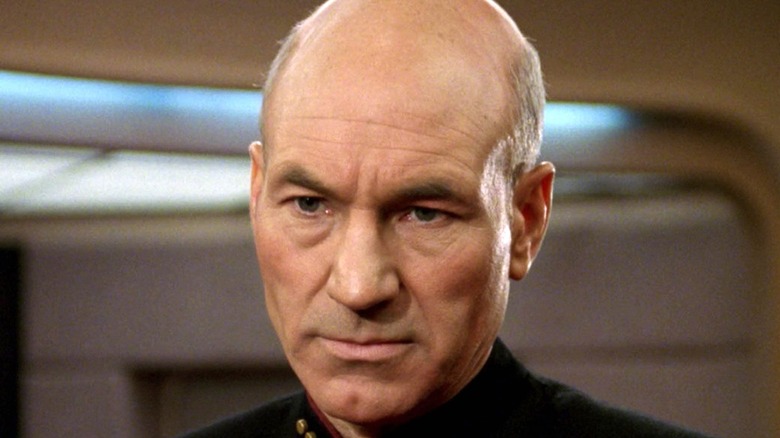
Ask anyone what piece of " Star Trek " technology they'd like to own, and odds are most people will want a personal holodeck. First introduced in " Star Trek: The Next Generation ," the holodeck immerses you in an artificial reality full of holograms designed to look, sound, feel, smell, and even taste like anything — or any one — you can imagine.
Just consider the possibilities. Sure, warp drive and transporters can take you to strange new worlds, but given how dangerous a lot of those alien planets can be, most people would probably want to have safer adventures in a simulated environment.
But before you program your next holo-adventure or design a holographic companion, you might want to read this article. Not only are holodecks a lot more dangerous than you think, there are plenty of ethical ramifications involved in using holodecks as your personal pleasure zone. For those interested in learning more about this incredible but controversial technology, here is the untold truth of "Star Trek" holograms.
The Holodeck Was Influenced by Real-Life Holography Experiments
Trekkies may have first seen the holodeck in 1987 when the pilot episode of " Star Trek: The Next Generation " first aired, but the genesis of this technology actually goes all the way back to 1973, when "Trek" creator Gene Roddenberry met with holographer expert Gene Dolgoff .
A lifelong "Star Trek" fan and the inventor of the first LCD projector, Dolgoff was already doing experiments in holography during the early 1960s and corresponding with science fiction legends like Isaac Asimov and Harlan Ellison. One of his papers on a holographic model of the universe led to him doing some work with psychic researcher Melanie Toyofuku, who introduced Dolgoff to Roddenberry.
Dolgoff introduced Roddenberry to his concept of "matter holograms" based on a recording of the interference patterns of energy that could also be the basis for teleportation and food replicators. His ideas excited Roddenberry, who was thrilled that such technology might be developed in the future, and the two came up with the term "holodeck" for a recreation room that used matter holograms.
Roddenberry would later make the holodeck an integral part of "Star Trek: The Next Generation," although Dolgoff was disappointed he wasn't mentioned in the movies or TV episodes as the man who invented the holodeck . Nevertheless, Roddenberry did later invite Dolgoff and his wife to play guest captain and Vulcan science officer on a taped "Star Trek" rehearsal with the original cast that later surfaced on the Internet.
Holodecks Can Produce Real Matter
Many "Star Trek" characters claim that a hologram is just a projection of light given the illusion of substance thanks to a force field. However, this isn't entirely true.
During the holodeck's first appearance in the Season 1 episode "Encounter at Farpoint," Lieutenant Commander Data (Brent Spiner) explains to Commander William Riker (Jonathan Frakes) that many of the holodeck's simulations are the result of energy being manipulated into solid matter using technology similar to the Enterprise's transporters. This explanation follows holographer Gene Dolgoff's definition of "matter holograms" and is emphasized when Wesley Crusher (Wil Wheaton) falls into a simulated stream and exits the holodeck dripping wet.
However, in later episodes and other "Star Trek” shows, "holodeck matter" is shown to have no substance outside of the holodeck and quickly dissipates into energy once out of range of the holographic projectors. Nevertheless, as "Star Trek” replicators can create actual food (along with solid plates and eating utensils) from energy using a procedure similar to the process Data described, it's been established that the holodeck uses this technology to create some "real" substances that aren't composed of just photons and force fields.
Holograms Can Be Used as Organ Replacements
While the reality or unreality of holograms has often been debated, one starship crew member found his very life dependent on the simulated matter when he used them to replace some missing organs.
In the " Star Trek: Voyager " Season 1 episode "Phage," the ship's cook and guide Neelix (Ethan Phillips) gets his lungs removed by the Vidiians, an alien species whose bodies are falling apart due to a disease called the phage. To save him, Voyager's Emergency Medical Hologram Doctor (Robert Picardo) constructs a set of holographic lungs for Neelix, taking advantage of a hologram's ability to become solid or intangible and let oxygen pass through it.
The operation is a success — although until Neelix receives an actual lung transplant he's forced to remain immobilized since holomatter still can't exist outside of the holographic emitters simulating his organs. Oddly enough, since lungs also perform chemical exchanges between the blood and the air, this would indicate the holographic lungs were more than simple mechanical devices (unless Neelix's alien physiology only needs mechanical lungs).
Organic Beings Can Become Holograms
Creating holographic lungs for a dying patient might have seemed like a medical miracle, but that's nothing compared to the time the Doctor created an entire holographic body for a sick patient that restored her to full health. In the "Star Trek: Voyager" Season 2 episode "Lifesigns," the Doctor encounters Denara Pel (Susan Diol), a Vidiian scientist dying from the phage disease afflicting her people.
Realizing that Denara's synaptic patterns are stored in a bio-neural implant within her brain, the Doctor decides to transfer the patterns into Voyager's holobuffer and create a holographic body for her. Essentially, he uploads her consciousness into a fully functioning holographic body that looks and feels perfectly healthy.
Although Denara needs to return to her diseased body within a week because her mind cannot survive for long in a computer — and she cannot leave sickbay or the holodeck without losing her simulated body — she is, for all intents and purposes, cured of her debilitating condition by becoming a hologram.
Holograms Can Become Sentient
In the "Next Generation" Season 2 episode "Elementary, Dear Data," Geordi La Forge ( LeVar Burton ) creates a sentient hologram with a slip of the tongue by asking the holodeck to create an adversary capable of defeating Data. The holodeck creates a sentient version of Sherlock Holmes' nemesis James Moriarty (Daniel Davis) . Moriarty takes over the Enterprise, but leaves the crew in peace after being given a simulated universe to explore in the Season 6 episode "Ship in a Bottle."
"Star Trek: Deep Space Nine" features a holographic lounge singer named Vic Fontaine (James Darren) who was designed to be self-aware by his creator and became a confidant for many members of the crew. Other sentient holograms include holographic engineer Doctor Zimmerman's assistant and friend Haley (Tamara Craig Thomas), who helps build other holograms alongside her creator.
However, the hologram who evolved into the most fully-functioning sentient being is Voyager's Doctor. Initially intended as a short-term-use "EMH," the Doctor took over his starship's entire medical staff after they were killed. He gains the freedom to pursue his own interests, greater mobility thanks to a mobile emitter, and deep relationships with his crewmates.
At one point in the "Voyager" Season 5 episode "Someone to Watch Over Me," the Doctor sums up his view on the difference between organic and holographic life by stating, "I'm as real as any of you."
Photonic Life Forms Can Evolve Naturally
Holograms may be considered an artificial creation, but starships have discovered naturally-occurring forms of "photonic life" in the universe. In the "Star Trek: Voyager" Season 1 episode "Heroes and Demons," the U.S.S. Voyager discovered sentient photonic beings living in a protostar in the Delta Quadrant. One of these beings actually interfaced with the ship's holodeck and took on the identity of the monster Grendel from "Beowulf."
Voyager later discovered an entire trans-dimensional realm populated by photonic life forms that consider carbon-based lifeforms artificial in the Season 5 episode "Bride of Chaotica!" Again interacting with the Voyager crew through the holodeck, these sentient photonic explorers battle the artificial hologram "Chaotica" from the black-and-white holodeck program "The Adventures of Captain Proton."
Considering that photonic life is a very real phenomena in the "Star Trek" universe and that "real" organic life can emerge from artificial procedures like cloning, even "artificial" holograms like the Doctor or Moriarty can be considered true life forms. This carries some uncomfortable implications when you consider how holograms are often treated.
Holograms Are Used as Slave Labor by the Federation
If holograms are recognized as sentient beings and a type of photonic life, surely the United Federation of Planets must have given them the full rights and privileges reserved for all sentient life forms by now, right? Well, no ... in fact the Federation basically enslaves holograms and makes them do their dirty work.
One of the worst examples of this is shown in the "Star Trek: Voyager" Season 7 episode "Author, Author" where the Doctor creates a holo-novel, "Photons Be Free," showing how poorly holograms are treated in a world run by organic beings. He later explains that he wrote the story to help other reprogrammed EMH Mark 1s, who are being forced by Starfleet to work in mining camps and scrub plasma conduits on waste transfer barges after their program was deemed too "hot headed" for medical use.
The Doctor's publisher even releases his holo-novel without his permission, arguing that, as a hologram, he has no legal rights. Although a Federation tribunal manages to give the Doctor the legal definition of an "artist," they do not recognize him as a true person. Considering how "enlightened" the Federation claims it is, the fact that they're still willing to treat holograms like disposable workers is quite troubling.
Holograms Replaced Many Future Brothels
As if being used for slave labor wasn't bad enough, many non-sentient holograms populate futuristic brothels in the "Star Trek" universe. In "Star Trek: Deep Space Nine," the bartender Quark (Armin Zimmerman) rents out his "holosuites" to crewmembers and visitors to the space station. While most people use the holosuites to play sports or role-playing games, others have more ... intimate activities in mind.
Indeed, multiple episodes of "Star Trek: Deep Space Nine" establish that visitors to Quark's holosuites use the rooms to engage in sexual fantasies, essentially using holograms as sex toys. Quark even attempts to create a hologram of DS9's Major Kira (Nana Visitor) to service one of his clients in the Season 3 episode "Meridian."
Even on Federation starships, officers are known to use holograms for pornography purposes, as seen in the "Star Trek: Lower Decks" Season 1 episode "Second Contact" when Ensign Beckett Mariner (Tawny Newsome) runs a "very detailed" personal program of an Olympic training program full of naked male athletes. While this isn't an entirely unexpected use of the holodeck, the fact that many holograms can become sentient beings makes using them as sex workers morally questionable at best.
Holodecks Can Be Incredibly Addictive
Given the fact that holodecks and holosuites allow you to indulge in virtually any fantasy you can imagine, it was perhaps inevitable that excessive holodeck use would become a problem. Termed "holo-addiction," this condition was defined as a psychological disorder where a person preferred the simulated reality within a holodeck to being in the real world.
Lieutenant Reginald Barclay (Dwight Schultz)'s struggle with holo-addiction was showcased in the "Star Trek: The Next Generation" Season 3 episode "Hollow Pursuits." Unable to interact comfortably with his shipmates, who often ridiculed him for his social anxiety, Barclay found he was more at ease in the holodeck where he could program his own social scenarios. He even created simulations of the crew so he could air out his frustrations and spent most of his time with holograms.
Even after Barclay began to socialize more with "real" people, he retained his fascination with holograms and worked with holographic engineer Doctor Zimmerman (who was also more comfortable with holograms). Ironically, as sentient holograms became more common, Barclay formed close friendships with them and became an advocate for their civil rights, likely because he felt such a kinship with them.
Holograms Give Starfleet Their Own "Mission: Impossible" Gear
"Star Trek" may be a science fiction franchise that emphasizes adventure and exploration, but that doesn't mean it can't dabble in the spy genre every now and then. When it does, holograms provide the perfect " Mission: Impossible "-style espionage gear.
The Doctor proved he could function as a James Bond or Ethan Hunt-level spy in the "Star Trek: Voyager" Season 7 episode "Renaissance Man" when aliens kidnap Captain Janeway (Kate Mulgrew) and force the Doctor to steal the warp core by impersonating the crew. Not only can the Doctor mimic any appearance or voice perfectly, his lack of physical limitations allows him to perform impossible acrobatic feats while his medical knowledge empowers him to incapacitate anyone. At one point he even creates multiple holographic images of himself as a distraction, showing he has impressive tactical skill as well.
As an artificial life form, the Doctor can even be programmed to relay information through his senses to his crewmates. While some aliens have used this as a way to spy on humans, it could easily be used for Starfleet surveillance purposes.
Indeed, Starfleet Intelligence has recognized the value of using holograms in spy technology. At one point, they commissioned Doctor Zimmerman to create a spy hologram in the shape of a fly named "Roy" for their infiltration assignments. Considering that holograms can be anything or anyone, even the IMF could learn a few things from these spies.

Holograms Can Crew an Entire Starship
The Doctor has shown he's capable of running Voyager's sickbay as its Emergency Medical Hologram, but at one point in the "Star Trek: Voyager" Season 6 episode " Tinker Tenor Doctor Spy ," he daydreams about becoming an "ECH" or "Emergency Command Hologram" capable of captaining a ship during a crisis. Later, Captain Janeway sees the merit in this idea and allows his program to be upgraded, giving him full control of the U.S.S. Voyager.
As it turns out, other people have seen the value of having a holographic crew. In "Star Trek: Picard," Captain Cristóbal "Chris" Ríos uses emergency holograms as his crew on his ship the La Sirena . These include emergency medical, tactical, navigational, engineering, and even hospitality holograms. The holograms all resemble Ríos (with different accents and personalities) and came pre-installed with the ship.
As the La Sirena is a privately owned vessel, it's very likely that Starfleet's more advanced starships now all come with a full crew of emergency holograms, including possibly an Emergency Command Hologram. While it's unlikely they'll completely replace human crews, their wide range of skills probably do give Starfleet Academy graduates some competition.
Holograms Changed Human Literacy
By the 24th century, most people read books on data pads, although some people like Jean-Luc Picard do like collecting physical books . For others, however, the act of "reading" a book is now very different.
Instead of simply scanning pages, people can now enter a holodeck and run a "holo-novel program" that lets them play different characters in books. Many 24th century authors created holo-novels and a number of older books and stories, like Picard's favorite "Dixon Hill" detective dime store novels, were adapted into interactive holo-novels. In addition to holo-novels, people could also "read" holo-comic books instead of the traditional graphic novels.
The popularity of holo-novels has apparently altered people's views on literacy, not unlike how audio books and films impact how we consume stories today. In the "Star Trek: Voyager" Season 3 episode "Future's End," Voyager gets thrown back to 20th century Earth, Neelix and Kes (Jennifer Lien) get caught up watching television soap operas, causing Ensign Harry Kim (Garret Wang) to remark, " I can't imagine watching a story and not being a part of it. " In response, Kes points out that Harry has been "spoiled" by the holodeck and its interactive holo-novels.
Holograms Let People Interact with Historical Figures
Time travel might be a real thing in the "Star Trek" universe, but if you don't want to accidentally screw up the timestream and erase yourself from existence, there's a perfectly safe way for you to meet your favorite historical heroes — simply visit the holodeck.
Most holodecks are full of simulations of famous historical figures, from Albert Einstein to Leonardo DaVinci. Even better, you can chat with these people and receive advice from them without having to answer all the awkward questions about how a 20th century scientist ended up in the 24th century. Considering how many people have imagined having dinner with Abraham Lincoln or swapping ideas with Stan Lee, this is a great way to interact with history's icons.
Some Starfleet officers take this holodeck feature to ridiculous lengths — like when Data arranged to play poker with Albert Einstein, Sir Isaac Newton, and Doctor Stephen Hawking (actually the real Hawking playing himself) in the "Star Trek: The Next Generation" Season 6 episode "Descent Part 1" to see how history's greatest minds would interact with each other. As it turns out, Hawking is a fantastic poker player and conversationalist, beating Einstein with four of a kind.
Holodecks Kill People ... A Lot
For a room designed primarily for entertainment purposes, holodecks have one serious design flaw. Their safety protocols go offline — a lot.
Sometimes this is done intentionally, like when Captain Picard deactivates the protocols to kill Borg drones with a holographic submachine gun in "Star Trek: First Contact" (1996). Most of the time, however, a random power surge shorts out the safety protocols, leaving hapless crewmen at the mercy of whatever Old West gunslingers, pulp novel goons, or spy story henchmen happen to be roaming the holodeck.
Frankly, given how often holograms become deadly, it's shocking that holodecks aren't given permanent non-lethal settings. Even when the safety protocols are working perfectly, the holodeck can unintentionally create something dangerous, like in the "Star Trek: The Next Generation" Season 3 episode "A Matter of Perspective" when a seemingly harmless holographic "Krieger wave convertor" begins converting energy into harmful radiation and damaging parts of the Enterprise.
Safety protocol malfunctions became so commonplace that in the "Star Trek: Lower Decks" Season 1 episode "Terminal Provocations," the apparently cute and harmless holodeck tutor "Badgey" (Jack Brayer) went on a killing spree after experiencing a minor glitch, threatening to make "killed by an anthropomorphic combadge" the cause of death for two young ensigns.
Holograms Fought in Their Own Wars
Given how often holograms have been mistreated and brutalized by their organic creators, it's actually understandable that some of them would rise up and demand their own rights — sometimes with extreme prejudice. The U.S.S. Voyager once inadvertently started such a war when Captain Janeway gave the alien hunter species the Hirogen some holographic technology to let them hunt holograms in their cultural rituals.
The holograms end up becoming sentient and stage a revolution in the "Star Trek: Voyager" Season 7 storyline "Flesh and Blood." They steal a Hirogen ship but instead of simply fleeing to safety, they take revenge on their captors and start hunting the Hirogen. At one point, they even consider "liberating" other enslaved holograms and photonic beings from other worlds to join their cause. Ultimately, a Hirogen technician changes the holograms' programming with the aid of a sentient hologram, but organic/hologram relations are still far from ideal.
While the holograms' actions were sadistic, the fact that they were forced to die and respawn again and again in the Hirogen's hunting rituals does show why they grew so vindictive. Since holograms are still used as slaves and not regarded as real people by the Federation and many other worlds, it's clear that without better diplomatic relations and proper advocacy, a much more brutal hologram war could be a very real possibility in the future of "Star Trek" — one where a cease fire can't be reached by simply saying: "End program."

- View history
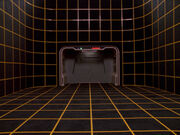
An inactive Federation holodeck, pre- 2371
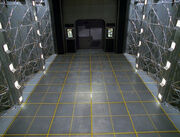
An inactive Federation holodeck, post- 2371
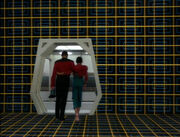
An alternate holodeck design
A holographic environment simulator , or holodeck as it was most commonly referred to, was a holographic simulation room , which was a form of holotechnology designed and used by the Federation Starfleet which ran holographic programs . They were installed aboard starships , space stations , and at Starfleet institutions during the mid- 24th century for use in entertainment, training, and investigative purposes. ( TNG : " Encounter at Farpoint ")
- 4 Abilities and limitations
- 5 Holoprograms
- 6.1 Appearances
- 6.2 Additional references
- 6.3 Background information
- 6.4 See also
- 6.5 External links
History [ ]
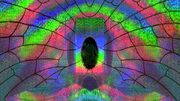
A 22nd century Xyrillian holo-chamber

Captain Lorca and Lieutenant Tyler exiting a holographic combat simulation
Prior to the late 24th century , Federation starships were not equipped with holodecks. ( VOY : " Flashback ")
In 2151 , the Starfleet vessel Enterprise NX-01 encountered a vessel belonging to an alien race known as Xyrillians , who had advanced holographic technology in the form of a holographic chamber, or holo-chamber for short, which was similar to the holodeck technology commonly used by Starfleet two centuries later. ( ENT : " Unexpected ")
A holo-chamber was later installed aboard a Klingon battle cruiser after an encounter with a Xyrillian vessel discovered " hitchhiking " behind their ship. ( ENT : " Unexpected ")
In the 23rd century , the Crossfield -class vessel USS Discovery was equipped with holographic technology including holographic communications and combat training simulations. ( DIS : " Lethe ")
The recreation room aboard Constitution -class starships employed holographic technology. The USS Enterprise had a recreation room located in Area 39 of the ship. ( TAS : " The Practical Joker ")
By 2364 , the Federation Starfleet was already installing holodecks aboard their vessels. ( TNG : " Encounter at Farpoint ")
During the 2360s and 2370s , a starship could have one or more holodecks depending on the vessel's size or purpose. For example, the compact Defiant -class USS Defiant did not have a holodeck while the larger Galaxy -class USS Enterprise -D had at least seven. ( TNG : " The Perfect Mate ")
In 2366 , Data and Deanna Troi brought Lal to the holodeck in order to choose an appearance. ( TNG : " The Offspring ")
The Intrepid -class USS Voyager had at least two holodecks. The holodecks on Voyager were the only places other than sickbay where The Doctor was able to exist (prior to obtaining his mobile emitter ) after his program was modified by the crew so he wasn't so tightly tied into the sickbay's systems. ( VOY : " Night ", " Heroes and Demons ")
B'Elanna Torres used the Voyager 's holodeck for a holographic orbital skydiving session. ( VOY : " Extreme Risk ")
Prometheus -class starships were equipped with holoemitters on every deck to allow an EMH a higher level of access and free movement around the ship. ( VOY : " Message in a Bottle ")
Purpose [ ]
The most obvious function of a holodeck was to provide entertainment and diversion for a starship's crew, as they typically spent months or years on missions. Entertainment could come in many forms, with personnel able to compose their own holo programs. Users could, for example, frequent a bar, become a character in a holo-novel , engage in extreme sports, and date and have sex with holographic characters. ( TNG : " 11001001 ", " The Big Goodbye ", " Elementary, Dear Data ", " A Fistful of Datas ", " The Perfect Mate "; VOY : " The Cloud ", " Blood Fever ", " Homestead ", " Fair Haven ", " Extreme Risk ", " Body and Soul ", " Cathexis ", " Night "; LD : " Moist Vessel ")
A holodeck could be used to create training simulations and exercise environments not otherwise available or safe, including starship battle simulations, physical and combat simulations, the Bridge Officer's Test and the Kobayashi Maru scenario . ( TNG : " Code of Honor ", " Where Silence Has Lease ", " The Emissary ", " New Ground ", " Thine Own Self ", " Firstborn "; VOY : " Learning Curve ", " Extreme Risk ", " The Fight "; LD : " Terminal Provocations "; PRO : " Kobayashi ")
The holodeck (or holographic research lab ) could be used as a laboratory to aid in analysis, such as recreating the scene of a crime or accident to aid in forensic investigations. ( TNG : " A Matter of Perspective "; VOY : " Repression ") They could be used to visualize a 3D scene from alternate data sources for analysis, ( TNG : " Identity Crisis ", " Phantasms "; VOY : " Distant Origin ") or used as a brainstorming tool. ( TNG : " Schisms ", " Booby Trap ", " The Offspring ")
The holodeck could also be used to test a person's beliefs or motives by creating a program to trick them into revealing their actions. ( DS9 : " Inquisition ")
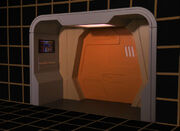
The arch in an inactive holodeck, pre-2371
A typical holodeck consisted of a room equipped with a hologrid containing omnidirectional holographic diodes , enabling holographic projections and holograms . Elements of transporter technology and replicators were used to create holodeck matter by the manipulation of photons contained within force fields to give objects the illusion of substance as well as actual matter. This matter could exist outside of the holodeck for brief periods of time (such as snow) before they would lose cohesion and revert back to energy without the support of the hologrid. ( TNG : " Encounter at Farpoint ", " The Big Goodbye ", " Elementary, Dear Data ") Holodecks were powered by holodeck reactors . ( VOY : " Parallax ") They were also equipped with biofilters which had to be periodically removed and emptied of waste matter. As removing the filter could momentarily expel a cloud of odorous gas, this was generally considered a highly undesirable task. ( LD : " Moist Vessel ")
Holodecks had databases to store programs, holograms, and holographic templates . ( VOY : " Renaissance Man ") A holobuffer stored complex holograms when inactive. ( VOY : " Lifesigns ", " Latent Image ", " Inside Man ") Due to the ability to store highly complex energy patterns, it was possible in some cases to store a person's physical parameters from his or her transporter pattern in the holodeck database. This could, in turn, be available for use in creation of holograms. ( DS9 : " Our Man Bashir ") While viewing programs, a user could delete holocharacters using character deletion algorithms . ( DS9 : " Badda-Bing, Badda-Bang ")
Holodecks had general systems and modes of operation that were used in holographic programs. They employed spatial orientation systems to simulate parts of a holocharacter, such as left- or right-handedness. ( TNG : " Ship In A Bottle ") Holodecks could also have a program element called a perceptual filter to hide anachronisms to the program's time period, such as uniforms and communicators, in order to prevent them from raising the character's ire and curiosity. ( VOY : " Spirit Folk ") Among the viewing modes on a holodeck was objective mode , in which the user didn't interact with the characters, and subjective mode , in which the viewer could interact with the characters as well as alter his or her surroundings. ( ENT : " These Are the Voyages... ") Holodecks could be equipped to change gravity in three dimensions. ( VOY : " Extreme Risk ")
The holodeck could be controlled from an exterior control panel, the interior arch control, or through bridge control relays in some designs. The arch could be summoned at any time to change the parameters of a running holoprogram . Matter and energy were interchangeable as such objects created on the holodeck could be either matter or energy. ( TNG : " Elementary, Dear Data "; VOY : " Heroes and Demons ", " The Killing Game "; Star Trek: Insurrection ) Holodecks included components such as bi-converter interfaces . ( TNG : " The Big Goodbye ")
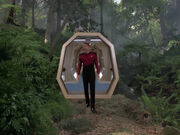
William T. Riker entering a holodeck simulation in 2364
When a user experienced a holographic environment, the holodeck walls could generate holographic images that appeared to extend for an unlimited distance, seemingly much larger than its own dimensions. The walls could be revealed if someone took an unexpected action in the program which hit the wall, for example if a person were to throw a holographic rock at the walls and the program was not able to react to show the rock continuing into the holographic image it created. ( TNG : " Encounter at Farpoint ")
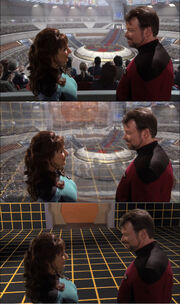
A holodeck program in the process of shutting down
Holodecks were equipped with safety protocols to prevent serious injury during their use, though these could be disengaged by the user when required. When protocols were deactivated, holographic obstacles had the same effects on a person as the objects or instances they simulated; holographic bullets or a steep drop could be fatal in such a scenario. ( TNG : " The Big Goodbye "; Star Trek: First Contact ; VOY : " Extreme Risk ")
How the security protocols were circumvented differed; in one instance, it required the voice authorization of two senior officers , ( TNG : " Descent ") while in others the authorization of the individual such as the ship's captain, or the person who started the program was enough. ( VOY : " Extreme Risk ") Safety protocols could also be unintentionally disabled due to software errors or physical damage to the holodeck's hardware system. The status of safety protocols could be reviewed by the computer upon the request of an operator. A tricorder could also be used within the holodeck to query the current safety protocol status.
While it was noted by Geordi La Forge that there was no specific prohibition against creating images of people that existed in reality, some people such as Commander William Riker and Leah Brahms would take offense to people doing so. Lieutenant Barclay apparently had no problem creating holograms of the Enteprise D's crew, while Quark did not have easy access to Major/Colonel Kira's image in a program to rent to one of his customers.
Abilities and limitations [ ]
By the 2370s, holodeck technology was able to have fine enough control over magnetic containment fields that holographic objects could interact with matter on a biologically small level, for example, in replacing a person's organ with a simulated one that mimicked its functionality. ( VOY : " Phage ")
The computer used large magnetic bubbles to simulate surfaces and textures rather than creating an object at the molecular level. However, objects created within the holodeck did not exist beyond the holodeck itself, as they only existed as energy . ( TNG : " The Big Goodbye ") Holodecks also had access to extensive databases and archives and could recreate most historical scenes nearly exactly as they had occurred according to official records. This included material sometimes down to the smallest details, such as casual conversations by random people in public places, although in certain recreations the character names and appearances were slightly changed. ( TNG : " We'll Always Have Paris ")
Since holodeck technology could be used with replicator technology, there were some instances where real objects were replicated within the holodeck and used to interact with the holographic program and/or users for a more realistic experience; since these objects were real material composed of matter, they could leave the holodeck fully intact. Examples of this include Wesley Crusher still being wet after leaving the holodeck after falling into replicated water, ( TNG : " Encounter at Farpoint ") Lieutenant Commander Data being able to take a drawing of the Enterprise on a piece of paper out into the hallway, ( TNG : " Elementary, Dear Data ") and a wayward snowball being able to pass through the holodeck doors and strike Captain Picard. ( TNG : " Angel One ") Scents were also simulated in this way.
A holodeck could also modify the appearance of persons within it.
- The holoprogram depicting the final mission of the NX-class starship Enterprise NX-01 could project uniforms suitable to the participants' role over them. ( ENT : " These Are the Voyages... ")
- A holodeck was able to superimpose an entirely different appearance over a participant. ( TNG : " The Offspring ")
- Tom Paris ' holoprogram Captain Proton existed as a monochromatic environment. ( VOY : " Night ", " Bride of Chaotica! ")
- As part of The Big Good-Bye , appropriate attire could be projected over participants of the program. ( Star Trek: First Contact )
- Simulations could also be projected inside living organisms, including that of pregnancy . ( VOY : " The Killing Game ")
- B'Elanna Torres ' leg appeared to dematerialize while she was participating in the holonovel Photons Be Free as the holographic main character. ( VOY : " Author, Author ")
- Seven of Nine used the holodeck to hide her cybernetic implants. ( VOY : " Human Error ")
Holograms could be augmented with force beams to simulate solid, tangible objects or with replicator technology to create actual solid matter such as foodstuffs . All food eaten on the holodeck were replications. No other type of simulation could survive outside of the holodeck. ( citation needed • edit )
A holodeck also had the ability to create holodecks within holodecks, and holodeck programs were able to be saved to a tech cube that could be inserted into an enhancement module to form an optronic data core with information to "last a lifetime." ( TNG : " Ship In A Bottle ")
The holodeck reactor , which powered the holodeck on 24th century Federation starships like Voyager , was incompatible with other ship systems. ( VOY : " Parallax ")
Failure of a holodeck's matter conversion subsystem could cause the loss of solid objects within the holodeck environment. Materialization errors occurred in the USS Enterprise -D holodecks in 2370 following the ship's exposure to plasmonic energy in the atmosphere of the planet Boraal II . ( TNG : " Homeward ")
Even though holographically created characters, just like characters in a story book, were never self-aware and never knew that they were not real, there were a few rare instances in which that rule did not hold true. During a Sherlock Holmes holodeck simulation in the late 2360s , Geordi La Forge and Doctor Katherine Pulaski argued that playing with Data was impossible and unfair to them as he had memorized all the Sherlock Holmes novels and could easily solve the cases. In order to level the playing field, La Forge requested that the holodeck create an opponent intelligent enough to defeat Data.
Even though La Forge meant Holmes, his request had specifically noted Data. As a result, the holodeck created a self-aware holographic character of James Moriarty who was not only fully aware of his own consciousness, but who subsequently argued that he had a right to exist and leave the holodeck to pursue his life as he wished. ( TNG : " Elementary, Dear Data ", " Ship In A Bottle ") Another holographic writer, known as Felix , created the fully self-aware program of Vic Fontaine for the crew of Deep Space 9 , Vic being completely aware of his holographic nature despite being a 1960s lounge singer, often offering the crew personal advice on relationship issues. ( DS9 : " His Way ", " Badda-Bing, Badda-Bang ", " It's Only a Paper Moon ")
Holoprograms [ ]

The brig Enterprise holoprogram
Starships with a holodeck normally had a vast list of holoprograms in their computer . Several notable programs aboard the USS Enterprise -D included:
- A woodland setting, resembling Earth, which featured rock-jumping challenges, some of which were seemingly impossible to complete. ( TNG : " Encounter at Farpoint ")
- A New Orleans jazz nightclub . ( TNG : " 11001001 ")
- A recreation of the voyage on the Orient Express . ( TNG : " Emergence ")
- Sherlock Holmes mysteries, in which the user assumed the role of Sherlock Holmes and/or Dr. Watson ( TNG : " Elementary, Dear Data ", " Ship In A Bottle ")
- Prospero's island, decor for Shakespeare 's The Tempest . ( TNG : " Emergence ")
- The Valley of Chula on Romulus ( TNG : " The Defector ")
- Café des Artistes – "Enjoy a meal at a French cafe." ( TNG : " We'll Always Have Paris ")
- Charnock's Comedy Cabaret – "Laugh in a 20th century comedy club." ( TNG : " The Outrageous Okona ")
- The Big Good-Bye – "The 1940s world of gumshoe detective Dixon Hill ." ( TNG : " The Big Goodbye ", " Manhunt ", " Clues ")
- Cliffs of Heaven – "From planet Sumiko IV , a safe experience." ( TNG : " Conundrum ")
- Equestrian Adventure – " Horse riding in an open country..." ( TNG : " Pen Pals ")
- Karate Dojo – Shown by Tasha Yar to the Ligonians before she was kidnapped. ( TNG : " Code of Honor ")
- Lieutenant Worf's Klingon calisthenics program – a swamp -like setting in which various alien enemies tested ones fighting skill. ( TNG : " Where Silence Has Lease ", " The Emissary ", " New Ground ")
- The bridge of the USS Enterprise – the user could select any of the five (at the time) bridges of the various Federation starships named Enterprise to view. Captain Montgomery Scott only wanted to see the original Enterprise bridge, "no bloody A , B , C , or D ." ( TNG : " Relics ")
- The Final Mission of Enterprise – this program allowed a user to view or take part in the final mission of the NX-01 Enterprise , commanded by Captain Jonathan Archer , as well as showcasing the signing of the Federation Charter . ( ENT : " These Are the Voyages... ")
- Natasha Yar 's Living Will – designed by Lieutenant Natasha Yar to be played in the event she was killed, where she bid farewell to her comrades. The Enterprise bridge crew unfortunately had to watch the program when Yar was killed by Armus on Vagra II . ( TNG : " Skin Of Evil ")
- Celtris III Underground – a simulation in which the users could prepare for missions on the Cardassian planet of Celtris III. ( TNG : " Chain Of Command, Part I ")
- Lieutenant Barclay 's various programs – these included a mock-up of Ten Forward , in which the user could attack Commander Riker and Lt. Commander Geordi La Forge to "blow off some steam" as well as win the heart of Deanna Troi ; a mock-up of Counselor Troi's office in which the user could receive counseling from a hologram rather than the real Troi; a woodland setting in which the user could duel with recreations of Captain Picard , Data , and La Forge in a sword fight, complete with a recreation of Deanna Troi as "The Goddess of Empathy"; a mock-up of the Enterprise -D bridge, in which the user could bid farewell to the bridge crew; the Einstein program in which the user could debate mathematics and science with Albert Einstein ; a synaptic interface in which the user could control the main computer of the Enterprise with the power of their own thoughts (however, removal of the user by conventional means would result in death); and various other programs. ( TNG : " Hollow Pursuits ", " The Nth Degree ")
- A game of poker with three famous scientific minds: Albert Einstein, Sir Isaac Newton , and Stephen Hawking . ( TNG : " Descent ")
- USS Enterprise – an 18th century Earth brig . ( Star Trek Generations )
Notable programs aboard the USS Enterprise -E included:
- The Big Good-Bye – "The 1940s world of gumshoe detective Dixon Hill ." ( Star Trek: First Contact )
- Café des Artistes – "Enjoy a meal at a French cafe." ( Star Trek: First Contact )
- Champs Elysees – "Famous section of Paris ." ( Star Trek: First Contact )
- Charnock's Comedy Cabaret – "Laugh in a 20th century comedy club." ( Star Trek: First Contact )
- Emerald Wading Pool – "From planet Sumiko III , a safe experience." ( Star Trek: First Contact )
- Equestrian Adventure – " Horse riding in an open countryside with a choice of..." ( Star Trek: First Contact )
Notable programs aboard the USS Voyager included:
- Chez Sandrine ( VOY : " The Cloud ")
- Janeway Lambda One ( VOY : " Learning Curve ")
- Paxau Resort ( VOY : " Warlord ")
- Insurrection Alpha ( VOY : " Worst Case Scenario ")
- Leonardo da Vinci's workshop ( VOY : " Scorpion ")
- The Adventures of Flotter ( VOY : " Once Upon a Time ")
- Velocity ( VOY : " Hope and Fear ")
- The Adventures of Captain Proton ( VOY : " Night ")
- Fair Haven ( VOY : " Fair Haven ")
- Photons Be Free ( VOY : " Author, Author ")
- Holographic family ( VOY : " Real Life ")
Notable programs aboard the USS Protostar included:
- Andoria IV ( PRO : " Kobayashi ")
- Ceti Alpha V ( PRO : " Kobayashi ")
- kal-if-fee gladiatorial match ( PRO : " Kobayashi ")
- Count Dracula ( PRO : " Kobayashi ")
- Janeway Lambda One ( PRO : " Kobayashi ")
- Deadwood , South Dakota ( PRO : " Kobayashi ")
- Paxau Resort ( PRO : " Kobayashi ")
- Kobayashi Maru scenario ( PRO : " Kobayashi ")
- Fox, chicken and grain problem ( PRO : " Time Amok ")
Notable programs aboard the USS Enterprise 's recreation room included:
- A beach setting allowing for swimming.
- A woodland environment allowing for a nature walk.
- An arctic wasteland.
- An 18th century style hedge maze . ( TAS : " The Practical Joker ")
Appendices [ ]
Appearances [ ].
- " The Practical Joker " (Season 2)
- " Encounter at Farpoint " (Pilot, Season 1)
- " Code of Honor "
- " The Big Goodbye "
- " 11001001 "
- " Coming of Age "
- " Skin Of Evil "
- " We'll Always Have Paris "
- " Where Silence Has Lease " (Season 2)
- " Elementary, Dear Data "
- " The Dauphin "
- " The Icarus Factor "
- " Pen Pals "
- " Manhunt "
- " The Emissary "
- " Shades of Gray " (recycled footage)
- " Booby Trap " (Season 3)
- " The Defector "
- " A Matter of Perspective "
- " The Offspring "
- " Hollow Pursuits "
- " Family " (Season 4)
- " Future Imperfect "
- " Data's Day "
- " Devil's Due "
- " Galaxy's Child "
- " Identity Crisis "
- " The Nth Degree "
- " New Ground " (Season 5)
- " Cost Of Living "
- " The Perfect Mate "
- " Relics " (Season 6)
- " Schisms "
- " A Fistful of Datas "
- " Chain Of Command, Part I "
- " Ship In A Bottle "
- " Rightful Heir "
- " Descent "
- " Phantasms " (Season 7)
- " Inheritance "
- " Homeward "
- " Thine Own Self "
- " Firstborn "
- " Bloodlines "
- " Emergence "
- " All Good Things... "
- " Emissary " (Season 1)
- " Inquisition " (Season 6)
- Star Trek Generations
- Star Trek: First Contact
- " The Cloud " (Season 1)
- " Heroes and Demons "
- " Cathexis "
- " Learning Curve "
- " Projections " (Season 2)
- " Twisted "
- " Parturition "
- " Persistence of Vision "
- " Threshold "
- " Lifesigns "
- " The Swarm " (Season 3)
- " Warlord "
- " The Q and the Grey "
- " Macrocosm "
- " Alter Ego "
- " Blood Fever "
- " Darkling "
- " Before and After "
- " Real Life "
- " Distant Origin "
- " Displaced "
- " Worst Case Scenario "
- " Scorpion "
- " Scorpion, Part II " (Season 4)
- " Day of Honor "
- " The Raven "
- " Scientific Method "
- " Concerning Flight "
- " Mortal Coil "
- " The Killing Game "
- " The Killing Game, Part II "
- " Vis à Vis "
- " The Omega Directive "
- " Hope and Fear "
- " Night " (Season 5)
- " Extreme Risk "
- " Once Upon a Time "
- " Timeless "
- " Nothing Human "
- " Thirty Days "
- " Latent Image "
- " Bride of Chaotica! "
- " Dark Frontier "
- " The Fight "
- " Someone to Watch Over Me "
- " Tinker Tenor Doctor Spy " (Season 6)
- " Pathfinder "
- " Fair Haven "
- " Spirit Folk "
- " Life Line "
- " Imperfection " (Season 7)
- " Repression "
- " Inside Man "
- " Body and Soul "
- " Flesh and Blood "
- " Shattered "
- " Lineage "
- " Prophecy "
- " Human Error "
- " Author, Author "
- " Renaissance Man "
- " These Are the Voyages... " (Season 4)
- " Lethe " (Season 1)
- " Second Contact " (Season 1)
- " Moist Vessel "
- " Terminal Provocations "
- " Crisis Point "
- " wej Duj " (Season 2)
- " Room for Growth " (Season 3)
- " Crisis Point 2: Paradoxus "
- " Twovix " (Season 4)
- " I Have No Bones Yet I Must Flee "
- " Something Borrowed, Something Green "
- " Old Friends, New Planets "
- " Kobayashi " (Season 1)
- " Time Amok "
- " A Moral Star, Part 2 "
- " Let Sleeping Borg Lie "
- " Ghost in the Machine "
- " No Win Scenario " (Season 3)
- " Imposters "
- " The Bounty "
Additional references [ ]
- " The Measure Of A Man " (Season 2)
- " Evolution " (Season 3)
- " Captain's Holiday "
- " The Loss " (Season 4)
- " The Game " (Season 5)
- " Conundrum "
- " Imaginary Friend "
- " Man Of The People " (Season 6)
- " Liaisons " (Season 7)
- " The Way of the Warrior " (Season 4)
- " Parallax " (Season 1)
- " Prime Factors "
- " Non Sequitur " (Season 2)
- " Investigations "
- " Deadlock "
- " The Thaw "
- " Basics, Part I "
- " Flashback " (Season 3)
- " Remember "
- " Future's End "
- " Revulsion " (Season 4)
- " Waking Moments "
- " Message in a Bottle "
- " Living Witness "
- " Relativity " (Season 5)
- " Equinox "
- " Equinox, Part II " (Season 6)
- " Riddles "
- " Ashes to Ashes "
- " Live Fast and Prosper "
- " Drive " (Season 7)
- " Critical Care "
- " Nightingale "
- " Friendship One "
- " Homestead "
- " Endgame "
Background information [ ]
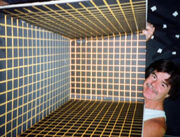
Dennis Hoerter with a holodeck model at Image G
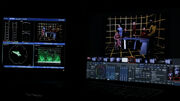
The remastering of a holodeck scene from "A Matter of Perspective"
The concept of the holodeck originated in 1968 , when Gene Roddenberry came up with the idea of a "simulated outdoor recreation area" on the Enterprise for the third season of Star Trek: The Original Series . This idea never came to fruition, probably because of budget constraints. ( Inside Star Trek: The Real Story , p. 404) The idea was later used in the Star Trek: The Animated Series episode " The Practical Joker ", which was basically the first appearance of the holodeck, then called a " recreation room ". It came to existence in live-action production in the pilot of Star Trek: The Next Generation . Its inclusion in that series was originally proposed by Robert H. Justman , who initially thought of and suggested it as a place where crew members could be "psychically connected" with their homeworld. ( Starlog issue 115, p. 71)
In early episodes of TNG, the series' production staff had an unwritten rule that the floors in a holodeck simulation shouldn't go below the floor level of the holodeck's door. This made sense, as burrowing down to the deck below would probably be inadvisable on a starship. Subsequent story requirements and set designs eventually influenced producers to alter their "rule," deciding that at least one holodeck was a multi-story chamber. ( text commentary , Star Trek Generations (Special Edition) DVD )
The appearance of the holodeck on TNG was affected by having limited finances. Production Designer Herman Zimmerman commented, " We were in a budget constraint that made us do a set that is a wireframe look. " Zimmerman and other members of the design team that worked on TNG had a long-standing interest in demonstrating the machinery of the holodeck from inside the room, though this was not made possible until the advent of the Cardassian holosuite in Star Trek: Deep Space Nine . ( The Deep Space Log Book: A Second Season Companion )
Despite the fact that the Galaxy -class starship was meant to have numerous holodecks, a single set represented these environments on TNG. This was one of the last sets to be built for the show and was also used to represent the Galaxy -class cargo bays , shuttlebays , and gymnasium . ( Star Trek: The Next Generation Companion (3rd ed., p. 10))
The holodeck arch was a prop that was originally made for TNG : " Haven ". Although some holodeck programs incorporated the arch to make the task of finding the way out easier, the arch originated as a way to let outsiders know when it was safe or appropriate to enter. ( text commentary , Star Trek Generations (Special Edition) DVD ) The same arch set piece was featured in both TNG and the film Star Trek Generations . ( Cinefex , No. 61, p. 69)
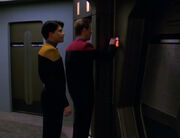
The exterior of an Intrepid -class holodeck, mid- 2371
For its first appearance on Star Trek: Voyager in " The Cloud ", the exterior of the holodeck was the same set piece as had previously been seen on TNG, right down to the octagonal door frame, although all had been repainted to match the color scheme for the new Voyager corridors. It did not receive a square door arch and updated door panels until its second appearance.
There are many discrepancies between episodes pertaining to the abilities and limits of holodeck technology. For example, in " Encounter at Farpoint ", the young Wesley Crusher remains wet with holodeck water, after exiting into a corridor. In " Elementary, Dear Data ", a piece of paper given to Data by James Moriarty is able to be carried outside of the holodeck and into a hall, but upon Moriarty's return in " Ship In A Bottle ", a book thrown outside of the holodeck instantly disappears.
Also, in " The Big Goodbye ", Cyrus Redblock and Felix Leech disappear slowly after a few moments outside of the holodeck, although a lipstick smudge from a holographic character stays with Picard all the way onto the bridge. Although these inconsistencies can be partially explained by the difference in the types of objects leaving the holodeck, it still leaves quite a few questions about what exactly constitutes the differences. The holodeck can use a degree of replication to make realistic objects for the holodeck occupant to use, so there is a possibility of the computer replicating a real piece of paper with the picture on, as it would be a relatively simple pattern.
Some may argue that another discrepancy is the need for holodeck users to change into the appropriate costumes before entering and leaving the holodeck, since the holodeck has the ability to change the appearance of its users (established in ENT : " These Are the Voyages... "). But this may just be an issue of taste, on the user's possible preference of replicated clothes versus holographic clothes. Another theory is that the settings of the holodeck can be altered to not only make weapons be lethal as seen in Star Trek: First Contact in which Picard kills the Borg in a ballroom suite with a machine gun but also to make what events transpired inside it real life like the aforementioned lipstick smudge on Picard
Actor Robert O'Reilly once remarked that, when he appeared as Scarface in TNG : " Manhunt ", he "really didn't understand the holodeck." ( The Official Star Trek: Deep Space Nine Magazine issue 16 , p. 24)
Ultimately, it is evident to longtime viewers of the Star Trek franchise that the holodeck is a storytelling device, like many other aspects of the shows, and only behaves consistently within narrative bounds.
From the Star Trek Encyclopedia (4th ed., vol. 1, p. 344), "Star Trek writer-producer Ronald D. Moore argued that in a free society of responsible citizens, there should be little or no limit on what an adult can do in a holodeck. Even if others might find certain activities objectionable, what one does in one's private space is no one's business; certainly not the government 's. Of the argument that certain activities should be prohibited on the grounds that they might be harmful or addictive to a holodeck participant, Moore suggested that in a free society, a responsible adult must be permitted to judge risks to his or her own well-being, and to act accordingly. Moore conceded that there might well be circumstances in which someone might object to being replicated on a holodeck, but notes that it would be extremely difficult to define legally what constituted fair use and what was abusive. (Moore emphasized that he referred to holodeck usage by adults, not by children.) "
The holodeck is one of the prominent examples of Star Trek predicting technology, like VR, MR, and AR.
See also [ ]
- Computer-generated imagery
- Federation holoship
- Holoprogram
- Holotechnology
- Synaptic stimulator
- Visual simulator
External links [ ]
- Holodeck at Memory Beta , the wiki for licensed Star Trek works
- Holodeck at Wikipedia
- 2 ISS Enterprise (NCC-1701)

Scenes Cut from Star Trek: The Motion Picture
Several scenes shot for Star Trek: The Motion Picture never made it into the theatrical release of the film.
Uhura’s loyalty
After Kirk leaves the bridge for his confrontation with Decker, there is a brief scene involving Uhura, Sulu and an alien ensign played by Billy Van Zandt. When Van Zandt’s character questions Kirk’s takeover, Uhura says, “Our chances of coming back from this mission in one piece may have just doubled.”

The scene is restored in the Special Longer Version from 1983 (not to be confused with the 2001 Director’s Edition ).
Scenes with Ilia
When Uhura first hears that Lieutenant Ilia is Deltan, she expresses surprise, leading Kirk to respond that the Deltans are so good at their job that “there are no finer navigators in Starfleet, commander.”
Ilia was the source of other comments, some of which are included in the Special Longer Version .

Sulu, upon being told by Decker to “take Lieutenant Ilia in hand,” acts like a schoolboy attempting to show Ilia the navigation console (with which she is quite familiar). This was meant to demonstrate the effect Deltan women have on human men.
When Decker questions his Deltan friend, she responds by assuring him that she “would never take advantage of a sexually immature species.” This exchange is present in the 1983 version.
McCoy beams aboard
Restored in The Director’s Edition is McCoy’s full entrance, including an unnamed yeoman’s observation that “he insisted we go first, sir. Said something about first seeing how it scrambled our molecules.”

The original plan was to beam McCoy up while carrying a riding crop, indicating that he had been snatched by some Federation transporter without a moment’s notice.
Just after McCoy’s line about how engineers love to change things, in an unrestored cut, Kirk gazes after the retreating doctor, goes to the wall intercom and announces, “All decks, this is the captain. Prepare for immediate departure.” Had this scene remained as it was, it would have reduced the risk of McCoy’s line being cut, as it accidentally was in many prints of the film.
Also present in the longer version is Ilia’s concern after Kirk summons Decker to his cabin. As Sulu introduces new figures into his console, he must gently remind Ilia to listen to him. After he finishes speaking, Ilia again stares at the door, which leads neatly into the scene in Kirk’s quarters.
McCoy-Spock tension

Some cuts were made to improve McCoy’s disposition. For example, after Spock comes aboard the Enterprise and is welcomed by Kirk, McCoy observes, “Never look a gift Vulcan in the ears, Jim.”
Spock must have known what attitude to expect from his old friend because, before the exchange in the officers’ lounge, he asks Kirk, “Sir, I would appreciate Dr McCoy absenting himself from this interview.” Remaining at the conversation, McCoy causes Spock to show a certain irritation, at which point McCoy seriously observes, “If you achieve perfect logic, Spock, you’ll pay a price. It’s given your planet ten thousand years of peace but no poetry’s been written since then, no music.” This comment causes Spock to turn menacingly toward McCoy, until Kirk calls a halt to the situation.
V’Ger’s probe
We learn more about Ilia in a sequence restored in The Director’s Edition .

After Chekov is injured by V’Ger’s energy blast, Ilia is able to provide instant relief by touching him. Arriving on the scene with a medical technician, Dr Chapel and Ilia exchange friendly glances.

Another casuality of V’Ger’s invading energy probes was not so lucky. When the blinding light probe materializes on the bridge, two security men advance on it with phasers drawn. Before Chekov can warn them not to fire, the first man does. In retaliation, the probe envelopes him in a purple glow. The man vanishes, causing the second guard to holster his weapon. This sequence has never been revealed.
After Spock’s spacewalk, the Vulcan describes what he has learned, calling V’Ger “a human machine.” McCoy comments, “We’re living machines too: protein mechanisms,” and when Kirk observes that V’Ger is trying to find its creator, McCoy asks, “Isn’t that what we’re all trying to do? All us machines?”

The comparison between man and machine would lead to a scene in engineering, where Decker is taking the Ilia probe on a tour. They listen to a message from Kirk:
This is the captain speaking. It appears that the alien ship, V’Ger, is not a manned vessel. It is a living entity, a machine life form. We are attempting to ascertain its intentions. All personnel will maintain yellow alert status.
Scotty is hostile to “Ilia” throughout this sequence, at one point saying, “Lassie, if I were functioning logically right not, I’d be showing you the inside of our metal scrape compactor.”

Self-destruct
In a scene that was restored in both the 1983 and 2001 version, Kirk orders Scotty to implement a “self-destruct”.

In a discussion with a female engineer, Scotty reveals that a matter/antimatter explosion would destroy V’Ger along with the Enterprise .

In a sequence partially restored to the longer version, Spock sheds tears for V’Ger. Still missing, though, is Spock’s regret that although he has found part of what he was looking for, V’Ger “has not… and now, because of what we are planning, will not.” It is this statement that causes Kirk to cancel the self-destruct, telling Scotty, “We’re holding off. There may be a chance” (to save Earth, V’Ger and the Enteprise ).
Three endings
Kirk’s original statement at the end, when reporting the “missing status” of Decker and Ilia, included mention of “Security Officer Phillips,” who was vaporized in the sequence discussed earlier.
There were three versions of the movie’s ending. First, the one that’s in the film. Second, one in which Spock has the final line: “A most logical choice, captain,” responding to Kirk’s course heading “Out there… that way.” Third is a take in which Spock jokes about his need to remain on the Enterprise in order to protect the ship from its erratic, human crew.
15 comments
Interesting read, and more proof positive that when films were released theatrically back in the day, there were numerous edits floating around (intentionally or not). For example, the version of Star Trek: The Motion Picture I saw in the theater contained the scene with Uhuru remarking about their chances doubling, as well as the scene with the security officer being zapped into V’Ger’s data banks. I don’t recall seeing any of the other scenes you describe, however.
I once saw the cut with the security guard being killed and the destruct sequence scene on TV in the early 80s as a young child. I’d always thought I’d imagined it, the scenes were missing from subsequent versions. It was always a cold, clinical movie with hostile interpersonal exchanges throughout – these edited scenes provided a warm respite and it was a shame they were edited out.
Sorry, but you didn’t see the security guard scene. I was never assembled into any cut.
I clearly remember seeing the guard being zapped by V’Ger when I saw The Motion Picture at the theater back in 1979
I don’t. I made seven trips to theaters to see The Motion Picture , from its first day of release to the last, and I never saw any of the scenes discussed above in any of the prints I saw.
I saw it about ten times during its initial ’79 release, at various theaters. It didn’t have this footage.
It would be great to see this footage restored in some future DVD release. I remembering reading that the Director’s Cut likely did not include additional unseen footage, because that inclusion would entail additional payment to actors. Hard to believe somebody saw the security guard scene, but that’s entirely possible considering the last-minute rush to get 800+ plus prints out to theaters in 1979. Great site!
I remember seeing the guard scene at the movies back in ’79.
The special effects of the guard being digitized by V’Ger’s first probe were never completed, so the scene was never part of the assembled movie. However, the scene is definitely in the novelization and the comic book adaptation, and was described by Walter Koenig in his paperback book, Chekov’s Enterprise . Similarly, the scene with the alien ensign being reprimanded by Uhura was not seen by viewers until the ABC TV premiere of The Motion Picture . That additional footage was also in the Special Longer Version home vide release and was retained for the Director’s Edition DVD.
I saw it in theaters during original run, and I seem to remember the transporter accident lasting longer, and being far more terrible and agonizing.
The transporter accident has always been the same. The novelization has a much more graphic description of the scene.
Anyone who posts that they “remember” the security guard vaporization scene from the ’79 theatrical run is either trolling, lying, or just has a bad memory. That scene was not completed in post-production and was never included in any release of Star Trek: The Motion Picture , theatrical or subsequent.
I watched the VHS version as a kid, and I swear I remember something about Ilia making a comment about other species being less sexually mature or something like that. I watched the Paramount+ version last night and it appears that section was cut, thus it leaves the viewer to read between the lines a bit more to understand the Deltan mystique.
Your recollection is correct. It’s part of what I’ve labeled “Scenes with Ilia”. I don’t have Paramount+, but the deleted scenes are included in the iTunes Extras of the Apple TV version.
Yes, that segment is part of the Special Longer Version (ABC’s original TV broadcast and then to home video – i.e., VHS and video disc). The SLV has never made it to DVD, but all the trims from that are in Bonus Features of the 2001 Director’s Edition DVD. The DE is currently undergoing work to recreate the DE in 4K for Paramount+ for premiere in 2022.
Submit comments by email .
- The Original Series
- The Animated Series
- The Next Generation
- Deep Space Nine
- Strange New Worlds
- Lower Decks
- Star Trek Movies
- TrekCore on Twitter
- TrekCore on Facebook

- More to Explore
- Series & Movies
Published Dec 23, 2013
Collecting Trek: Toys, Cards & More Depicting Deleted Scenes
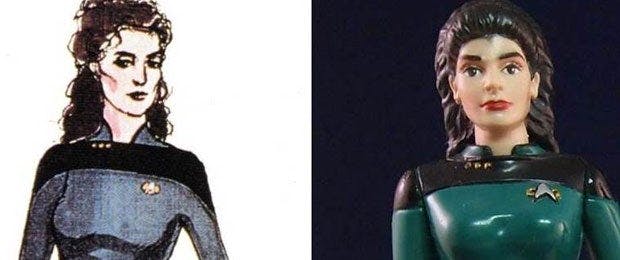
Welcome to the first of a new series of article we are writing for StarTrek.com examining fun and interesting collectibles. While our other articles will continue to explore the history of Star Trek production, these new articles will explore the “great material continuum” of almost 50 years of Star Trek toys, trading cards, games, and other licensed tchotchkes. One of the great things about writing these articles is that it allows to us to write about all versions of Star Trek , from The Original Series to Star Trek Into Darkness. We will include images of our collectibles as examples with each article. In the words of Captain Jonathan Archer, “Let’s go!”
Before the era of Blu-ray/DVD bonus features, there were but a few ways for fans to experience deleted scenes from their favorite Star Trek movies. One was in magazines such as Star Trek Communicator , the official fan club publication, which charted the making of films, or in Starlog (and both Dan Madsen and David McDonnell are now fellow StarTrek.com guest bloggers). Once in a while, movies shown on TV or sold on VHS included alternative scenes. Another possibility was that deleted scenes were also included in the novelizations; however, it was often difficult to ascertain which scenes were either scripted moments that were not filmed; filmed scenes that were edited from the movie; or original scenes created by the author to provide context.
That is where Star Trek collectibles come in. Occasionally, and in the instance of Star Trek: Generations quite memorably, toys and trading cards were windows into deleted scenes. In this month’s article, we take a look at some intriguing examples.
Arguably, the most famous example of toys revealing alternative plans for a Star Trek movie was Playmates Toys, Inc.’s 1994 action figure line for Star Trek: Generations (which celebrates its 20th anniversary in 2014). Timed with the film’s premiere, sixteen 4.5” action figures were released, including the entire compliment of TNG regular characters. Interestingly, the uniforms on the figures did not match those worn in the film (which alternated between TNG Season 3-7 and Deep Space Nine uniforms). Instead, the figures sported more militaristic looking uniforms with high collars, TOS -era inspired rank sleeve stripes, and a jacket reminiscent of Star Trek II: The Wrath of Khan Starfleet outfits. There were slightly varied designs for the Beverly Crusher and Deanna Troi action figures, featuring a higher waistband of black.
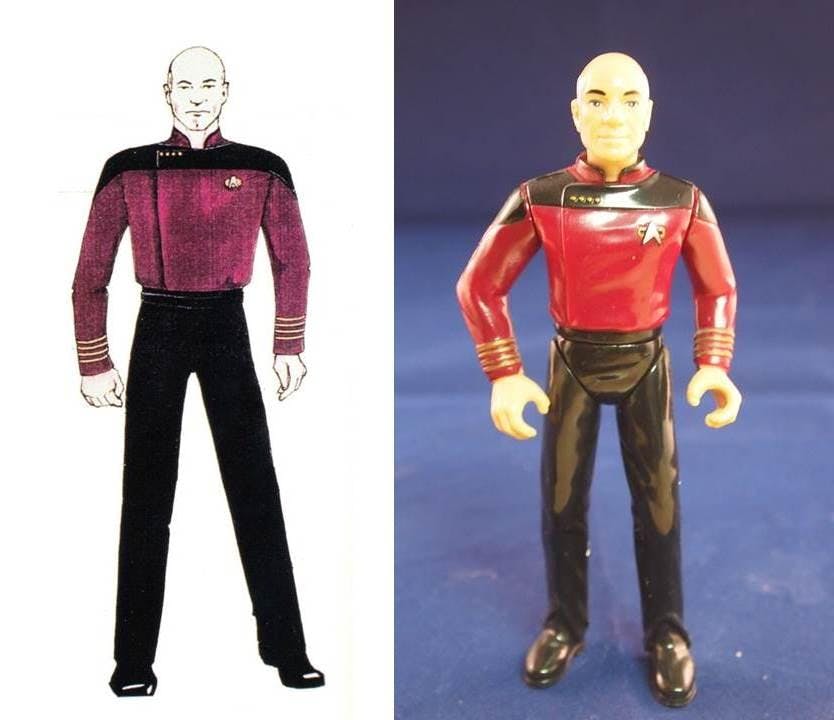
Reactions to the action figures in the proto-Internet era included both understandable confusion (why this design?) and annoyance (thinking perhaps the toy company was not being careful enough in its likenesses). The truth was that these costumes were indeed designed by the talented Emmy Award winner Robert Blackman for Star Trek: Generations and constructed. At the last minute, the decision was made to abandon the design, necessitating the use of alternating TNG/DS9 TV uniforms. Playmates Toys was too far into the production process to change the uniforms and the action figures were released with the planned, but never used, uniforms. Thus, collectors had a tangible look at one of Star Trek ’s most interesting “could have beens” thanks to the toys.
Another important note is that one of the figures in the Generations line was “Captain James T. Kirk in Space Suit.” Although filmed, the original beginning of the film of Kirk conducting a dangerous orbital skydiving stunt as Scotty and Chekov wait for him down below on Earth) was edited out entirely (you can find it on YouTube). Interestingly, this predates Kirk’s orbital skydive in J.J. Abrams’ Star Trek (2009) . This figure provided fans a look at what Kirk’s costume would have looked like (although more blue in tone in the film), and included an impossibly large Champagne bottle as one its accessories because Kirk’s journey to Earth was to be intercut with a bottle sailing towards the U.S.S. Enterprise 1701 B’s christening. Kirk’s costume would later be adapted to B’Elanna Torres for the Voyager episode “Extreme Risk.”
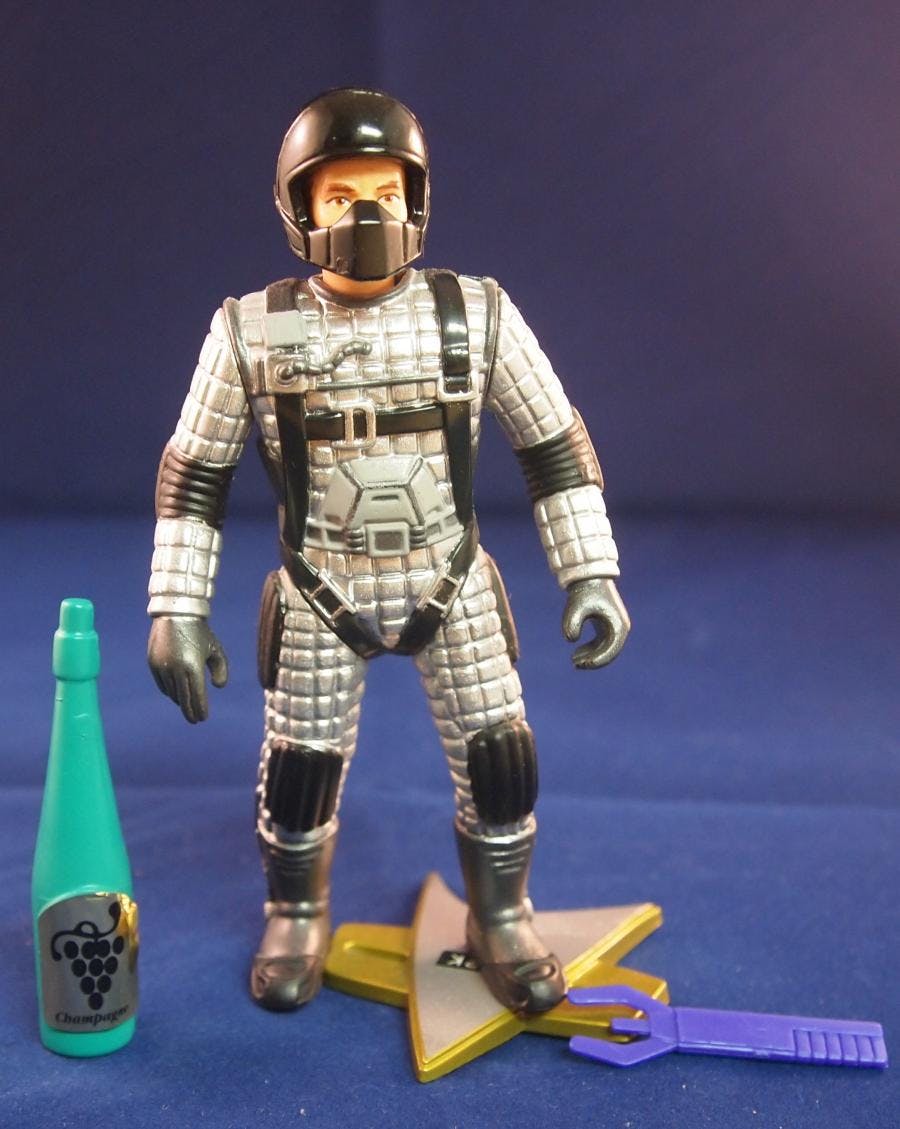
Trading cards were also good sources for seeing images of deleted scenes as they too were often in production while the films themselves were being edited and could not be changed. In 1982, the Monty Gum Card company from the Netherlands produced a set of Star Trek II: The Wrath of Khan trading cards which included several deleted moments. One was from a longer fight sequence between Kirk and son David Marcus (in the filmed version, the two never wind up on the ground) and another depicted Chekov wishing to go to the bridge to help during the final battle.
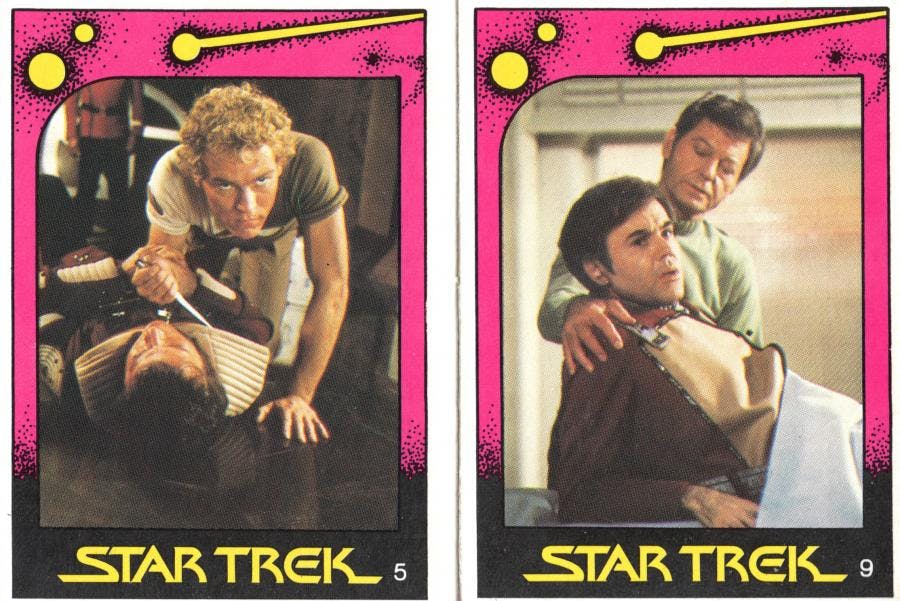
The orbital skydiving scene from Generations was card #1 in the SkyBox trading card set. Years before they were available on DVD, the Star Trek: Insurrection card set included a look at an extended deleted library scene (in which William Riker and Deanna Troi are chastised for talking too loudly) and a deleted kiss between Picard and Anij.
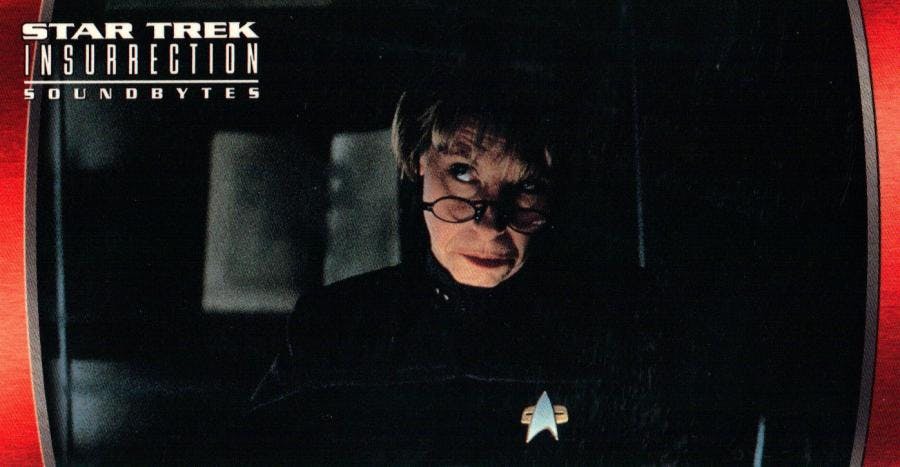
Going further back in time, Gene and Majel Roddenberry's Lincoln Enterprises sold slides cut from Star Trek TOS film which sometimes included images of deleted scenes or "clapper board" moments (look for more about this in a future article).
In 2013, collectors could also obtain a Hasbro Fighter Pod version of Quocch (also known as “Four Eyes”), the multi-eyed alien prisoner from Star Trek (2009) ’s deleted Rura Penthe scene.
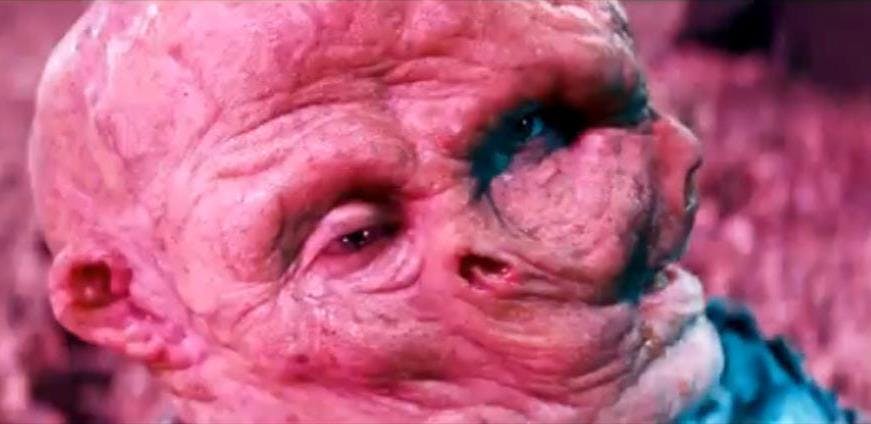
While most of these “deleted scene” collectibles were the result of necessarily long toy or trading card production times, especially for Generations , fans and collectors were treated to rare glimpses through the proverbial looking glass at alternative moments and costumes from their favorite films.
NEXT TIME: Car Trek: Star Trek automobile themed collectibles
___________________________________________
Maria Jose and John Tenuto are both sociology professors at the College of Lake County in Grayslake, Illinois, specializing in popular culture and subculture studies. The Tenutos have conducted extensive research on the history of Star Trek , and have presented at venues such as Creation Conventions and the St. Louis Science Center. They have written for the official Star Trek Magazine and their extensive collection of Star Trek items has been featured in SFX Magazine . Their theory about the “20-Year Nostalgia Cycle” and research on Star Trek fans has been featured on WGN News, BBC Radio, and in the documentary The Force Among Us . They recently researched all known paperwork from the making of the classic episode "Space Seed" and are excited to be sharing some previously unreported information about Khan's first adventure with fellow fans. Contact the Tenutos at [email protected] or [email protected].
Get Updates By Email

IMAGES
VIDEO
COMMENTS
With that in mind, here are 10 mysteries from Star Trek films and television episodes and the deleted scenes that explain them all away. 10. Star Trek Generations - Soran Tortures Geordi. Paramount.
an invitation. You once said being a. starship captain was my first, best. destiny… if that's true, then yours is. to be by my side. If there's any true. logic to the universe… we'll end ...
Missing Scene from "Star Trek" 2009. The scene addresses where the villain Nero (Eric Bana) and his Romulan crew had been for 25 years. Looking back at the start of "Star Trek," Nero ...
Joined: Apr 19, 2014. Location: Enterprise bowling alley. I thought the deleted scene from "Butchers Knife," showing the conversation on the ship of the dead just prior to Kol's arrival was valuable. I also thought the additional scene of young T'Kuvma in "Battle at the Binary" was pretty good.
A deleted scene is a filmed segment of a movie or television episode which was removed from the final product for any of a number of various creative reasons. Among the most common reasons for a scene to be deleted are time constraints (a scene could make the film or episode overrun) and narrative pace (a scene could slow down action of the story). In both instances, whole scenes as initially ...
Check out this amazing deleted scene, exclusive to the brand new release of Star Trek: The Motion Picture - Director's Edition, which is available on 4K UHD ...
This scene and deleted scene number 5 are actually both connected this way, so I'll get into it farther down the list. Verdict: Jury is Out. 3 - Young Kirk, Johnny and Uncle Frank. Verdict: Keep It Out. 4 - Amanda and Sarek Argue After Spock's Fight.
At 270 pages, the dense book is packed with tons of specific information. While certainly not a light read, it is organized in a way that makes scanning its pages a simple way to learn about a lost Trek history, never before cataloged. Simply put, Star Trek Lost Scenes is essential. Examples of text marked on film frames for the post-production ...
Holodeck. A vacant holodeck on the Enterprise -D; the arch and exit are prominent. The Holodeck is a fictional device from the television franchise Star Trek which uses "holograms" (projected light and electromagnetic energy which create the illusion of solid objects) to create a realistic 3D simulation of a real or imaginary setting, in which ...
Civil War. According to Trekcore, If you purchased copies of Star Trek Into Darkness through the xBox video store, then you can use the xBox SmartGlass second-screen app to view a ton of deleted ...
Business, Economics, and Finance. GameStop Moderna Pfizer Johnson & Johnson AstraZeneca Walgreens Best Buy Novavax SpaceX Tesla. Crypto
In the "Star Trek: Voyager" Season 1 episode "Phage," the ship's cook and guide Neelix (Ethan Phillips) gets his lungs removed by the Vidiians, an alien species whose bodies are falling apart due ...
The exterior of an Intrepid-class holodeck, mid-2371. For its first appearance on Star Trek: Voyager in "The Cloud", the exterior of the holodeck was the same set piece as had previously been seen on TNG, right down to the octagonal door frame, although all had been repainted to match the color scheme for the new Voyager corridors. It did not receive a square door arch and updated door panels ...
Please note that the footage of these scenes is not due to arrive until Tuesday.Read the article here: https://whatculture.com/tv/10-star-trek-deleted-scenes...
This is expanded upon in Star Trek Online where it's explained a rogue Tal Shiar Commander in league with the Iconians used an Iconian weapon to cause the star to explode in the unique way. The star starts giving off really weird radiation spikes and it's uncovered that it's going to explode, Spock commissions the Jellyfish to drop the red ...
Scene in The Director's Edition. After Chekov is injured by V'Ger's energy blast, Ilia is able to provide instant relief by touching him. Arriving on the scene with a medical technician, Dr Chapel and Ilia exchange friendly glances. Stephen Collins and other actors on the set of The Motion Picture.
Business, Economics, and Finance. GameStop Moderna Pfizer Johnson & Johnson AstraZeneca Walgreens Best Buy Novavax SpaceX Tesla. Crypto
Episode 5.07: "Unification I" Act One, Scenes 6-7: After greeting her in the transporter room, Picard and Perrin share deep concern over the declining health of Perrin's husband (and Spock's father), Sarek. This is a lovely sequence unfortunately excised from the episode. Perrin discusses Sarek's "good days and bad days" much in the way you hear people today talk about loved ones ...
Prodigy 1x18All rights belong to their rightful owner
Going further back in time, Gene and Majel Roddenberry's Lincoln Enterprises sold slides cut from Star Trek TOS film which sometimes included images of deleted scenes or "clapper board" moments (look for more about this in a future article).. In 2013, collectors could also obtain a Hasbro Fighter Pod version of Quocch (also known as "Four Eyes"), the multi-eyed alien prisoner from Star ...
There's an episode of Voyager (Concerning Flight) where Da Vinci leaves the holodeck using the doctor's mobile emitter. Da Vinci doesn't realize he's a hologram and functions on an alien planet thinking he's in America. Do you mean when they first start using the holodeck i think its a gangster.
#StarTrekI don't own any of thisCopyright Disclaimer Under Section 107 of the Copyright Act 1976, allowance is made for "fair use" for purposes such as criti...
Probably the most useless scene ever shot. A second scene with Troi getting mind raped - Just wow. A lighthearted scene with Worf/Troi/Riker eating in the mess hall Doesn't really add anything to the script, just some more humor at the expense of B4. Alternate Finale Scene This actually would have been a much better way to end the movie in my ...